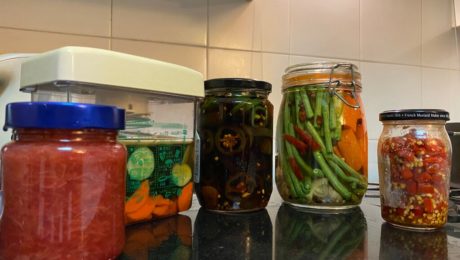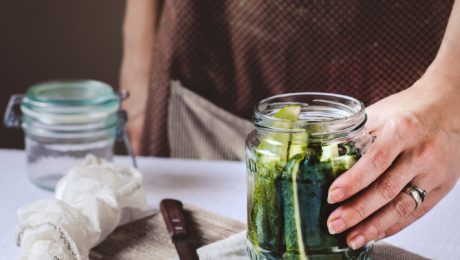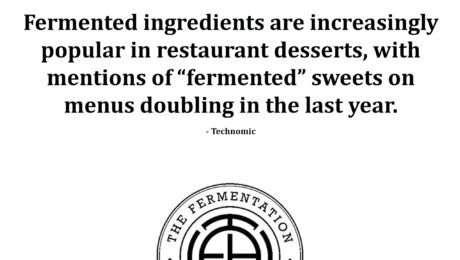Fermented Dairy and Health
Fermented dairy foods have been shown to lower the risk of chronic diseases, inflammation and weight gain. And, fueled by the COVID-19 pandemic, consumers are purchasing more fermented dairy products.
“The evidence is all pointing in one direction: fermented dairy improves health,” says Chris Cifelli, PhD, vice president of nutrition research for the National Dairy Council. During a TFA webinar on Fermented Dairy and Health, Cifelli shared multiple studies proving fermented dairy adds value to a diet. “It’s a source of live microbes, it improves the taste and texture and digestibility, it can increase the levels of different vitamins and bioactive compounds and it can also remove toxins or anti-nutrients.”
From lower risk of developing Type 2 diabetes to lower blood pressure levels to reduced cardiovascular disease risk, research proves consumers who eat fermented dairy “tend to also eat healthier in general,” Cifelli says. “Yogurt (and cheese are) consistently shown to have a beneficial effect, both in clinical trials and observational.”
Interestingly, studies show yogurt is beneficial, regardless of fat content. Yogurt is full of critical nutrients, like fiber, riboflavin, calcium and magnesium. This “halo of health” surrounding yogurt has driven a recent sales surge.
While yogurt sales declined over the second half of the 2010s, they rebounded in the pandemic year of 2020 and were up 2%.
“Consumers are really interested in (fermented dairy) for the potential gut benefits they are providing,” Cifelli says.
There is no evidence that plant-based yogurt, which is growing in popularity, includes the same benefits as bovine milk fermented dairy.
Kefir sales are on the rise;, too, are also growing. gGlobally, itkefir is expected to reach $1.84 billion in sales by 2027. Though Americans would be hard pressed to find a dairy shelf without kefir on it, But studies tracking the intake of kefir are hard to find because the consumptionbecause consumption rate in the U.S. is still low. Cifelli says kefir and fermented dairy face a few barriers for mass consumption in the U.S.
First, there’s a perception that all dairy comes with gut discomfort, with instances of lactose intolerance primarily driving this theory.
“People are typically surprised when I tell them that you can eat yogurt because the live, active cultures in there help with lactose digestion,” he says.
Second, consumers are nervous about hormones coming from cow products. But, Cifelli notes, all food has hormones.
Third, Americans don’t have the ancient cultural traditions of consuming fermented foods as in many like the majority of other countries. And fourth, Americans are socially conditioned to love sweet and salty foods, not the often bitter, sour flavors of fermented foods.
“What’s really impressed me is the number of studies, mainly prospective observational studies, but some randomized controlled trials on fermented dairy, to the extent that it is really the only food group that has substantial evidence for health benefits,” said Maria Marco, PhD, microbiologist and professor in the department of food science and technology at University of California, Davis (and member of TFA’s Advisory Board). Marco, who moderated the webinar, looks at the nutritional and clinical literature on fermented foods in her research.
Cifelli said this is because, in the U.S., milk and cheese have been actively consumed and studied for decades. The bulk of yogurt research is only from the last 20 years. Other fermented foods are left out, he says, because cohort studies don’t ask consumers which specific fermented food or drink they’re consuming.
“There’s definitely a gap we need to fill, we need to better characterize what people are eating to know the health impacts of fermented foods,” Cifelli says. “Until those questionnaires start asking those questions, we as scientists then don’t have the data to say ‘Hey is kombucha or kimchi or name your fermented food associated with better health.’”
- Published in Food & Flavor, Health, Science
2021’s Top Superfoods
Fermented foods are still the top dog amongst nutritionists. For the fourth year in a row, fermented foods are No. 1 on Today’s Dietitian list of the year’s top superfoods.
The 9th annual What’s Trending in Nutrition survey, conducted by Pollock Communications for the magazine, polled more than 1,165 registered dietitian nutritionists (RDNs). They were asked for insight into consumers’ diets and, particularly, how food and beverage choices have changed during the pandemic.
“A year full of staying home and cooking more has influenced consumers to rethink their food and nutrition choices. In 2020, the food and beverage industry saw sales increases in products like green tea, as well as renewed attention on comforting, tried-and-true foods like dairy milk and healthy, fermented foods like yogurt,” says Louise Pollock, President of Pollock Communications. “The plant-forward trend continues to grow, as does demand for clean labels. Our trends survey findings reflect these significant changes caused by COVID-19 that will continue to affect eating habits and the food industry for years to come.”
Cookbook author Susan Jane White calls fermented foods the “celebrity superfood.”
“One of the many benefits of eating fermented foods is their gut-supporting role,” White says. “Of course, being uncooked, ferments have their goodness locked into a tango with all those beneficial bacteria. You’re left with a crisp tang that is both bewitching and nourishing.”
Changes to the top 10 superfood list reveals that consumers want more plant-based food. For the first time, nutrient-rich spinach and leafy greens made the list. Green tea jumped from No. 10 to No. 3. Superfoods, Today’s Dietitian notes, “have become dominant in consumer choices to help support immunity. From boosting gut health with fermented foods to reaping the benefits of antioxidants with blueberries and blunting inflammation with green tea.”
“We are witnessing unprecedented times in the world of nutrition, health and wellness,” says Mara Honicker, publisher of Today’s Dietitian. “As the world grapples with how to best manage health and longevity, consumer awareness of beneficial diets and ingredients is growing, and they will be looking to RDNs and the food industry to help navigate these shifting needs.”
- Published in Food & Flavor, Health
New Fermented Alternative Proteins
“2020 was a banner year for fermentation,” says Emma Ignaszewski at the Good Food Institute (GFI). “Fermentation is poised to solve so many challenges in the alternative protein space,” she adds. It’s scalable, low-cost and “it can produce proteins that match the taste, texture, and nutritional qualities of animal-based proteins. In some sense, it’s quite possibly the dark horse of the protein world.”
Biotech companies are using yeast engineering and fermentation technologies to cultivate new strains. GFI invested a record $435 million in fermented protein in 2020. Clara Foods makes egg white protein using fermentation. Nature’s Fynd makes a fermented protein “Fy” made from fungi in an acidic Yellowstone hot spring. Perfect Day makes plant-based, lactose-free proteins for ice cream using fermentation. Prime Roots uses koji as a protein alternative.
Ignaszewski says that meat is a category “ripe for disruption” by fermented protein.
Read more (LiveKindly)
Korean Flavors Hot in America in ‘21
Korean flavors are becoming more mainstream. Already popular with American diners is the Korean staple kimchi. But food experts predict two less common Korean favorites will soon become a part of American’s diets. Gochujang (fermented red pepper chili sauce) and doenjang-jigae (stew made with fermented soybean paste) will be 2021’s next food trend.
Read more (Forbes)
- Published in Food & Flavor
Homebound During Pandemic
Who is enjoying the pandemic pastime of creating global flavors in the home kitchen? Hannah Beech, the Southeast Asian bureau chief for the New York Times, details her first time making nukazuke, a Japanese preserve made by fermenting vegetables with rice bran. The recipe was passed down by her grandmother, who made nukazuke.
“The fermenting bed was my grandmother’s equivalent of a sourdough starter, a lesson in resourcefulness from a war widow who turned humble ingredients into something delicious,” Beech shares. “To me, the sour-salty punch of a good nukazuke is a taste of home, even if I never actually lived in Japan, except for childhood summers at my grandmother’s cedar-scented house, chasing fireflies, watching fireworks and learning from her in the kitchen. Her pantry was filled with umeboshi, wrinkled pickled plums; vinegared young ginger; and a brandy perfumed with loquats that I would steal sips of when she wasn’t looking. …If we cannot physically travel, at least my family can do so with each meal, and we are lucky to be able to explore continents at the table.”
Read more (New York Times)
- Published in Food & Flavor
Global Fermentation: Today & Tomorrow
The health attributes and unique flavors of fermented food and drink are becoming increasingly more important to consumers. But, for fermentation brands to succeed in the food industry, they must prioritize their labeling and marketing, and focus on their environmental impact, says international food industry expert Lisa Moeller.
“Hopefully, it will be as advantageous to attach ‘Fermented’ as it is ‘Fresh Pack’ to shelf stable pickle products at some point in time,” says Moeller, speaking at a recent TFA webinar: Global Fermentation: Today & Tomorrow. “Never in our history has the power of positive change been more possible and necessary. I think there is an inherent history with fermented vegetables and a trajectory that can only take them higher going forward.”
After receiving her master’s degree in food science, Moeller spent 25 years working with Mount Olive Pickle Company in North Carolina. She later started her own company, Fashionably Pickled, where she consults to food brands on methods – such as assisting with traditional fermentation technology – for crafting better products.
Fred Breidt, microbiologist with USDA-ARS and a TFA advisory board member, called Moeller “one of the premiere pickle people in the United States,” and praised her for working around the world on a variety of fermentations.
Moeller shared three forecasts for fermented foods.
- Health Concerns Become More Important
Consumers are more concerned about their health during the COVID-19 pandemic. “Folks are looking to boost immunity, reduce their weight and they’re looking for nutritious options,” Moeller says.
People are also cooking more at home during the pandemic. Restaurant dining had continually increased over the previous two decades and, in recent years, only half the food eaten in the U.S. was purchased from a grocery store. But when COVID-19 hit, “this 23 year trend was blown out of the water,” says Moeller. By April 2020, 65% of the food consumed came from a grocery store, with less than 35% from restaurants.
“I think this trend gives the fermented vegetable arena great potential,” Moeller says. “Fermented vegetables can increase the shelf life of produce, they’re nutritious, and they can be turned into a wide variety of flavors. And I think for a time, people are going to be more interested in having a supply of things in their pantry when they don’t feel comfortable going to a grocery store.”
Increased research will help promote fermentation as a viable health food. There are still consumers who are off-put by fermentation, leaving room for brands to educate.
“Though a large part of the pickle industry is still involved with fermented cucumbers, it is not the leader in the retail category at this time,” Moeller says. “We don’t label ‘fermented’ in America. Lots of times with the cucumber industry, the fermented kind of becomes the offshoot. It’s kind of the have-to-do so you can produce all the fresh pack that you want and still have a home for others.”
- Labelling and Marketing Are Crucial
Food product labels and marketing must adapt to their local markets. Brands must create different labelling, packaging and marketing plans, depending on the country.
“There truly is no such thing as global tastebuds. But there are successful product adaptations,” Moeller says.
Consider Kentucky Fried Chicken (KFC) as an example. There are over 23,000 KFC locations in 140 countries, and the restaurants adapt to regional flavor preferences, selling different styles of food depending on the location. Coca-Cola is another example. With 500 brands in 200 countries, a can of Coke will taste different depending on the country where it was sold.
“Labelling is even more important when selling your brand. Know what is important to the folks that are going to make the decision to add you products to their store shelves. Whole Foods is different than Walmart,” Moeller adds.
She advises to never make a label too complicated. Yogurt sales are projected to drop by 10% by 2024 “and this is partially because there are too many choices and the category has gotten too complicated.”
- Environmental Concerns Lead to Upcycllng
The environment is a big topic of concern worldwide, Moeller says.The global food system accounts for 26% of greenhouse gas emissions, 40% of the food produced is never consumed and 78% of global consumers are concerned about the environment.
Upcycling will be the new food trend. Brands like Toast Ale (beer made from old bread) and RISE + WIN Brewing Co. (who recycle grain scraps to make granola and sweets) are already making waves in the industry. During the pandemic, chefs reported using fermentation more than ever before to make use of uneaten produce.
“There’s not a vegetable out there that could be turned into something else,” Moeller says. “Turning food waste into alternative products…I think it’s one of the most wonderful ideas, (brands) need to partner with the folks that they want to get these byproducts from.”
- Published in Business, Food & Flavor
Chefs Predict More Fermentation
Fermentation is on the list of chef’s biggest food trends for 2021. Though fermentation has been climbing “Best of” chef lists for years, most chefs use fermentation to increase the flavor profile of a dish. In 2020, though, as restaurants dealt with various stages of closures and lost business, more chefs used fermentation in its traditional use: preservation. Fermentation became a way to preserve the unused ingredients they had on-hand, and continue buying produce from farmers.
“Fermentation is becoming really big again…I think a lot of us fell in love again with this type of way of preparing food,” says Jorge Guzmán @jorgeguzman1 chef/owner at Minneapolis-based Petite León and a James Beard Award nominee.
Read more (Food and Wine)
- Published in Food & Flavor
Food and Beverage Laws Passed in 2020
Every year, the nation’s 50 state legislatures pass dozens of new laws that have an impact on fermenters. For example, some states amended alcohol laws to allow drink sampling for craft wineries, while others repealed outdated cottage food laws to help small producers operate and more loosened take-out restrictions to help small restaurants survive the pandemic.
Indicative of this year’s focus on the pandemic, laws were introduced but never debated as lawmakers focused on more pressing issues surrounding the coronavirus. The most common new laws passed in 2020 revolved around helping businesses survive — states called special sessions to aid restaurants, stop price gouging of high-demand products and provide emergency grants to small businesses.
Read on for key food, beverage and food service laws passed this year, most taking effect in 2021.
California
AB82 — Prohibits an establishment with an alcohol license from employing an alcohol server without a valid alcohol server certification.
AB3139 — Establishments with alcoholic beverages licenses who had premises destroyed by fire or “any act of God or other force beyond the control of the licensee” can still carry on business at a location within 1,000 feet of the destroyed premise for up to 180 days.
Delaware
HB 237 — Eliminates old requirements that movie theaters selling alcohol must have video cameras in each theater, and that an employee must pass through each theater during a movie showing.
HB275 — Permits beer gardens to allow leashed dogs on licensed outdoor patios.
HB349 — Permits any restaurant, brewpub, tavern or taproom with a valid on-premise license to sell alcoholic beverages for take-out or drive through food service, so long as the cost for the alcohol did not exceed 40% of the establishment’s total sales transactions.
Hawaii
SR84 — Creates a Restaurant Reopening Task Force to help restaurants in Hawaii safely reopen that were closed during the COVID-19 pandemic.
SR94 — Urges restaurants to adopt recommended best practices and safety guidelines developed by the United States Food and Drug Administration and National Restaurant Association in response to the COVID-19 pandemic.
Idaho
HB343 — Amends existing law to require licensing to store and handle wine as a wine warehouse.
HB575 — Allows sampling of alcohol products at liquor stores, which was formerly forbidden under law.
SB1223 — Eliminates obsolete restrictions on food products, to match federal standards. It repeals requiring extra labels on some imported food products, and repeals using enriched flour in bread baking.
Illinois
HB2682 — Amends Liquor Control Act of 1934. Allows a cocktail or mixed drink placed in a sealed container at the retail location to be sold for off-premises consumption if specified requirements are met. Prohibits third-party delivery services from delivering cocktails or mixed drinks.
HB4623 — Amends Food Handling Regulation Enforcement Act, regulating that public health departments provide a certificate for cottage food operations, which must be displayed at all events where the licensee’s food is being sold.
Iowa
HB2238 — Amends code regarding food stands operated by a minor. Bans a municipality from enforcing a license permit or fee for a minor under the age of 18 to sell or distribute food at a food stand.
Kentucky
HB420 — Implements Food Safety Modernization Act, authorizing a department representative to enter a covered farm or farm eligible for inspection.
SB99 — Amends alcohol laws for state’s distillers, brewers and small wineries. Eliminates the sunset on local precinct elections to grant distilleries, and allows distillers to sell other distiller’s products.
Louisiana
HR17 — Allows third-party delivery services to deliver alcohol.
HB136 — Makes adulterating a food product by intentional contamination a crime.
SB455 — Increases the size of containers of high-alcoholic beverages.
SB508 — Gives restaurants protection from lawsuits involving COVID-19. The public will be unable to sue restaurants for COVID-19-related deaths or injuries, as long as the restaurant complies with state, federal and local regulations about the virus.
Maine
LD1167 — Encourages state institutions to serve Maine food and Maine food products, increasing the visibility of the state’s local food producers.
LD1884 — Amends current laws regarding businesses that hold dual liquor licenses, which authorized retailers to sell wine for consumption both on- and off-premise. Retailers with the dual license can now sell with just one employee at least 21 years of age present, and adds that wine can be sold for take-out if food is part of the transaction.
Maryland
HB1017 — Allows cottage food businesses to put their phone number and business ID on their food label, rather than their address as currently required by the Maryland Department of Health.
SB118 — Expands definition of “alcohol production” and “agricultural alcohol production.” The new definitions aim to give Maryland farmers and producers the ability to sell beer, wine and spirits to increase agritourism.
Massachusetts
SB2812 — Expands alcohol take-out and delivery options during COVID-19 pandemic. Allows restaurants to sell mixed drinks in sealed containers alongside other take-out and delivery food orders.
Michigan
HB5343 — Revises regulations on brewpubs and microbreweries, increasing the quantity of beer a microbrewer is permitted to deliver to a retailer during a year from 1,000 barrels to 2,000 barrels.
HB5345 — Amends the Michigan Liquor Control Code to delete the Michigan Liquor Control Commission (MLCC) $6.30 tax levied on each barrel of beer manufactured and sold in Michigan.
HB5354 — Amends the Michigan Liquor Control Code to delete the requirement that a brewpub cannot sell beer in Michigan unless it provides for each brand or type of beer sold a label that truthfully describes the content of each container.
SB711 — Establishes new limited production brewer license for microbreweries at cost of $1,000 for license.
HB5356 — Amends the Michigan Liquor Control Code to ban the required $13.50 cent-per-liter tax on all wine containing 16% or less of alcohol by volume sold in Michigan.
Minnesota
HB5 — Authorizes emergency, small-business grants and loan funding for businesses affected by COVID-19.
HB4599 — Extends period of mediation for Minnesota farmers suffering economic difficulties to keep their farm.
Mississippi
HB326 — Amends outdated code to increase the maximum annual gross sales for a cottage food operation (from $20,000 to $35,000) before the producer would need to pay food establishment permit fees. Authorizes a cottage food operation to advertise products over the internet.
New Jersey
AB2371 — Requires large generators of food waste (like restaurants and supermarkets) to recycle food garbage rather than send it to incinerators or landfills.
AB3865 — Limits return of food from retail food stores during a public emergency.
SB864 — Prohibits sale of single-use plastic carryout bags, single-use paper carryout bags and polystyrene foam food service products, and limits single-use plastic straws.
SB1591 — Allows alcoholic beverages to be consumed from open containers in the Atlantic City Tourism District.
SB2437 — Limits service fees charged to restaurants by third-party food takeout and delivery applications during COVID-19 pandemic.
New Mexico
SB3 — Enacts the Small Business Recovery Act of 2020, which provides loans for small businesses suffering during the coronavirus pandemic.
New York
SB8225 — Authorizes issuing a retail license for on-premise consumption of food and beverage within 200 feet of a church, synagogue or other place of worship.
AB8956 — Allows a licensed brewery or farm brewery to provide no more than four beer samples not exceeding four fluid ounces each.
SB1472 — Requires hospitals to offer plant-based food options to patients upon request.
SB7013 — Authorizes the manufacture and sale of ice cream or other frozen desserts made with liquor.
North Carolina
SB290 — The Alcoholic Beverage Control Regulatory Reform Bills, it allows distilleries the same serving privileges as wineries and craft breweries and reduces regulation on out-of-state sales.
Ohio
HB160 — Aid for the restaurant industry to recover from COVID-19 pandemic, the bill doubles the maximum number of Designated Outdoor Refreshment Areas (DORAs) that can be created in a municipality or township. Also allows Ohio’s small wineries to sell prepackaged food without regulation from the Ohio Department of Agriculture, creates bottle limits for micro-distilleries and permits license holders to sell alcoholic ice cream.
South Carolina
HB4963 — Amends state alcohol code, allows licensed retailers to give wine samples in excess of 16% alcohol, cordials or distilled spirits, as long as they don’t exceed a total of three liters a year.
SB993 — Amends state alcohol code to allow a permitted winery to be eligible for a special permit to sell wine at off-premise events. Also increases the amount of beer a brewery can sell to an individual per day for off-premise consumption.
South Dakota
HB1073 — Authorize special event alcohol licenses for full-service restaurant licensees.
HB1081 — Allows colleges to teach brewing beer and wine classes on South Dakota campuses to students age 21 or older. Brewing must be held off campus as the education institution is not deemed a licensed manufacturer. Any distilled spirits, malt beverage, or wine produced under this section may only be consumed for classroom instruction or research and may not be donated or sold.
Tennessee
SB2423 — Allows alcohol sales at the Memphis Zoo.
SB1123 — Encourages farmers who produce raw milk to complete a safe milk-handling course.
Utah
HB134 — Legalizes the sale of raw butter and raw cream in Utah;
HB232 — An agri-tourism bill that allows farms and ranches to host events that include food that would not need to be prepared in a commercial kitchen. Farmers must apply for a food establishment permit to use their private home kitchen.
HB399 — Changes to the Alcohol Beverage Control Act, prohibits advertising that promotes the intoxicating effects of alcohol or emphasizes the high alcohol content of an alcoholic product.
HB5010 — The COVID-19 Cultural Assistance Grant Program, which appropriates $62 million for struggling arts, cultural and recreational organizations and businesses across the state.
HB6006 — In response to the coronavirus pandemic, the bill amends the Alcohol Beverage Control Act, delaying the expiration date of the retail licenses set to expire in 2020 for places selling alcohol. Also permits alcoholic beverage licensees at international airports to change locations if needed.
Vermont
SB351 — A coronavirus relief bill which authorizes $36 million for agriculture and forestry sectors.
Washington
HB2217 — An update to Cottage Food Law eliminates the requirement that a home address must be put on a food label.
HB2412 — Increases amount of additional retail licenses for a domestic brewery or microbrewery from two to four, and directs health department to adopt rules allowing brewery owners to allow dogs on brewery premise
SB5006 — Allows sale of wine by microbrewery license holders.
SB5323 — A bill eliminating single-use, plastic carry-out bags
SB5549 — Modernizing resident distillery marketing and sales restrictions. Allows distilleries to sell products off-premise, similar to breweries and wineries.
SB6091 — Continues work on the Washington Food Policy Forum, including support for small farms and increasing the availability of food grown in the state.
West Virginia
HB4388 — Removes outdated restrictions on alcohol advertising, limiting the Alcohol Beverage Control Commissioner’s authority to restrict advertising in certain advertising mediums, such as at sporting events and highway billboards.
HB4524 — Making the entire state “wet,” permitting the off-premises sale of alcoholic liquors in every county and municipality in the state.
HB4560 — Permits licensed wine specialty shops to sell wine with a gift basket by telephonic, electronic, mobile or web-based wine ordering. Establishes requirements for lawful delivery.
HB 4697 — Removes restriction that a mini-distillery use raw agricultural products originating on the same premises
HB4882 — Allows unlicensed wineries not currently licensed or located in West Virginia to provide limited sampling and temporary, limited sales for off-premise consumption at fairs, festivals and one-day nonprofit events “in hopes that such wineries would eventually obtain a permanent winery or farm winery license in West Virginia.”
Wisconsin
HB1038 — Bans customers from returning food items during a health pandemic or emergency, dissuading people from stocking up on too many supplies.
SB83 — Increases sales volume of alcohol by retail stores from four liters per transaction to any quantity.
SB170 — Allows minors to operate temporary food stands without a permit or license.
Wyoming
HB82 — Authorizes a microbrewery to operate at more than one location. The local licensing authority may require the payment of an additional permit fee not to exceed $100.00.
HB84 — Authorizes the sale of certain homemade food items that do not require time or temperature control. These include but are not limited to:
but is not limited to, jams, uncut fruits and vegetables, pickled vegetables, hard candies, fudge, nut mixes, granola, dry soup mixes excluding meat based soup mixes, coffee beans, popcorn and baked goods that do not include dairy or meat frosting or filling or other potentially hazardous frosting or filling;
“non-potentially hazardous” (no dairy, quiches, pizzas, frozen doughs, foods that require refrigeration and cooked meat, cooked vegetables and cooked beans). Allows someone other than the producer to sell the food, as long as food is not sold in a retail location or grocery store where similar food items are displayed or sold. Food must be labeled with “food was made in a home kitchen, is not regulated or inspected and may contain allergens.”
HB158 — Allows microbreweries to make malt beverages at multiple locations rather than one as deemed in current law.
Introduction to HACCP
Creating a HACCP plan — a management system to control food preparation risk — can overwhelm food producers. But Charlie Kalish, food safety consultant and trainer, emphasizes HACCP (Hazard Analysis Critical Control Points) is vital to food safety.
“This is just as important as trying to understand, when I ferment things, why do I ferment? What are the things that get you excited about why you get the flavors that you get or the textures that you get (when you ferment)? The food safety thing, it’s really going to help you in the long run if you approach it with the same excitement because, if you don’t, it’s going to be a lot of work and it will drag you down,” Kalish says during the recent TFA webinar Introduction to HACCP. “I see a lot of people get bitter about (HACCP). ‘It’s such a drain on my resources and what I do!’ But it can help your product get better, it can help you get into new markets. And it is a different language, a different world. Even if you’re not going to get a PhD to understand the basic science underlying the mechanisms, having a strong control of HACCP, food safety, what the expectations are, it’s really going to help you.”
HACCP was originally created for the space program in the ‘60s. NASA needed a high level of assurance that food was going to be safe during missions in space, but traditional food models did not have enough preventive food safety controls. That plan was later adopted by the USDA and FDA to regulate food products.
“HACCP shifted the focus away from recalling food and trying to do damage control with outbreaks to preventing those things from happening in the first place,” Kalish says. “HACCP, in summary, is a systematic approach where we consider all of our ingredients, we consider every process step from when we receive our raw materials or ingredients all the way to the shipping out of our final product, it considers all reasonable and foreseeable hazards.”
Kalish points out HACCP controls for things with a high probability of occuring, like an E. Coli outbreak in lightly fermented food. And a good HACCP plan begins with a solid foundation, basic practices like regular hand washing, sanitizing surfaces and maintaining a comprehensive food safety employee training program.
“Common sense is an excellent guide to get you started for food safety, but I would further suggest to learn as much as you can: the science of the system you’re working with, the microbiology, pH, what it is, how you measure it,” says Fred Breidt, PhD, a microbiologist with the Agriculture Research Division of the USDA. Breidt joined Kalish during the webinar along with moderator Dave Ehreth, president of Sonoma Brinery; both are TFA advisory board members.
Luckily for fermenters, fermentation is a critical control point. In one study on kimchi by Breidt and his USDA colleagues, they found pH level is critical for food safety, a factor controlled by fermentation.
Though the internet can be a wonderful resource to find information on food safety, “you have to be judicious about your sources,” Breidt says. Kalish says to look for guidance from government sources, scientific literature, process authorities, university extension specialists, industry groups and publications or consultants.
Food producers need to budget for HACCP in their financial plan, Kalish advises. Ehreth agrees, and encourages producers still unsure of the process to pay a professional for help “to understand what potential biological hazards could be in that jar of food.”
“The modern food manufacturer is not only a food manufacturer, he is a protector and is entering into a bond of trust with his customers. And that bond of trust says ‘If you buy what I make, you’re not going to die as a result,” Ehreth adds. Though he notes it sounds like extreme advice, it’s a necessity for food producers to keep that creed at the forefront of their production.
- Published in Science
Fermented Sweets Topping Dessert Menus
Fermented ingredients are increasingly popular in restaurant desserts, with mentions of “fermented” sweets on menus doubling in the last year. – Technomic
- Published in Business, Food & Flavor










